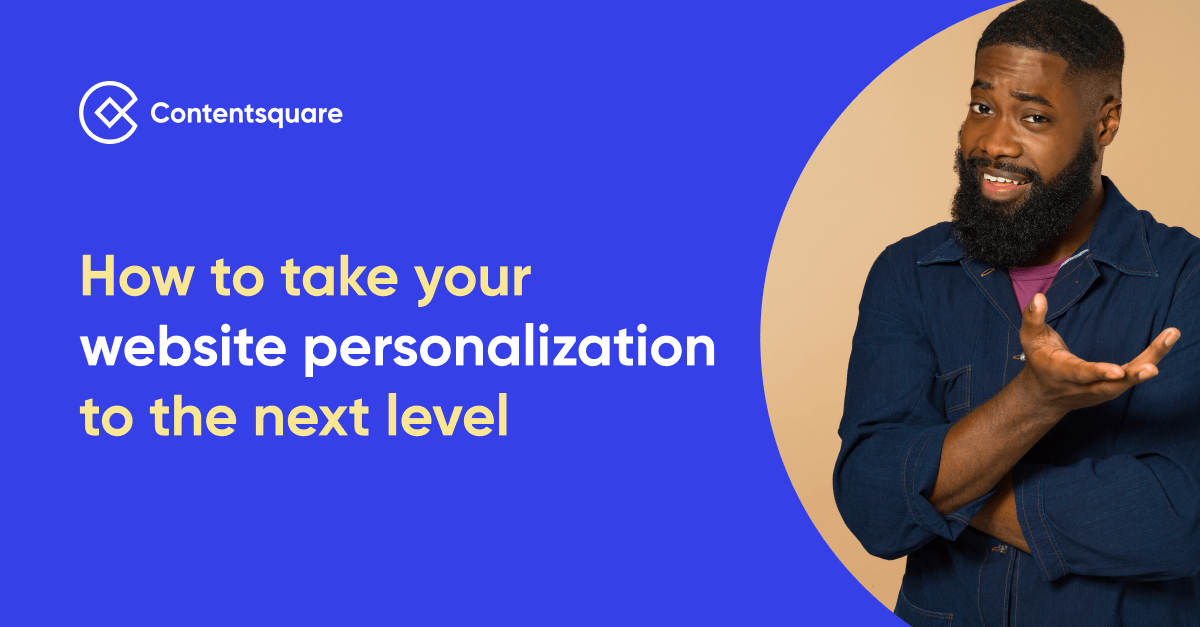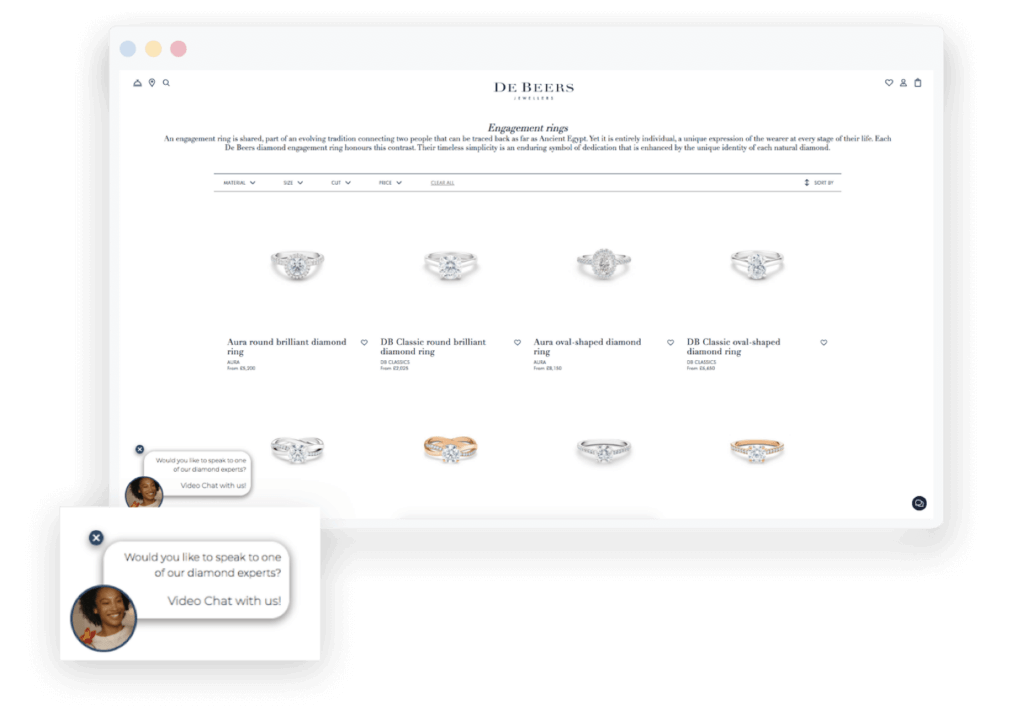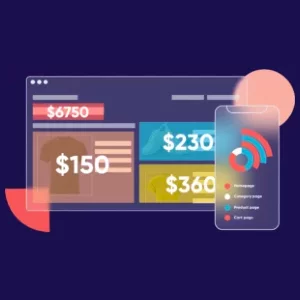
Ready to get personal?
Get access to our Personalization Hub to get insight from market leaders and take your digital experience to new heights.

Today, website personalization is table stakes for companies that want to stand out in a crowded online marketplace and to provide the kind of personalized experience that customers expect and love.
70% of attendees at a Contentsquare event said their companies saw website personalization as a company-wide priority. Brands are aware of how important personalization is becoming to their bottom line. However, only 24% said that they had the right resources in place to run personalization, meaning that knowing how to make personalization a reality remains challenging, even for those companies that understand how important it is.
“Most companies know that personalization is the future and what they should be striving to achieve. Not every brand is there yet, but certainly, the majority is working towards that level.” Harry Hanson-Smith, Regional VP – Nordics, APAC & UK, Dynamic Yield.
This blog aims to explain website personalization, outline the key benefits, and offer practical answers to the following questions using real-world examples and insights from leading brands, such as John Lewis, Ocado, Dynamic Yield and many more.
Website personalization is the process of creating customized experiences for website visitors. It involves understanding the emotions, motivations, and intent of website visitors so you can create more humanized digital experiences.
Online shopping has become a way of life for most people since the pandemic, and most of us now expect a personalized online experience.
According to Salesforce, 66% of customers expect companies to “understand their unique needs and expectations”, while 52% of customers expect offers to always be personalized A study by Accenture shows that 91% of customers are more likely to shop with “brands who recognize, remember, and provide relevant offers and recommendations.”
“Consumers expect to be recognized across devices whether that’s on the web or apps. They also expect to be able to interact 24/7, whenever it best suits them. Brands that are already doing this well have raised the level of expectation among consumers.” Veronica Saha, Head of Analytics, Zoopla.
The more relevant the website experience is for users, the longer they will stay on the site, which in turn leads to more product views and, ultimately, sales. This was the experience for Office Shoes when they personalized recommendations for their paid search traffic.
As the company’s eCommerce Trading Optimisation Manager Hiral Patel explains: “We have recommendations live for any paid search traffic that lands on PDP [a product detail page]. That helped us reduce our bounce rate by 29% for that specific group.”
Easier customer journeys, repeat visits, and more time on site tend, in turn, to lead to higher conversions. That is, more of your website visitors will become customers and make a purchase.
According to Statista, 63% of marketers have seen increased conversion rates as a result of personalization. Hiral Patel of Office Shoes backs up this statistic with her company’s experience:
“Last calendar year, our recommendations campaign drove a 28% y-o-y uplift in direct revenue.”
When you tailor your online experience to reflect what your customers want to achieve, you make that customer journey easier. This leads to longer time on site as well as more repeat visits, which, in turn, leads to repeat sales. As Zoopla’s Head of Analytics Veronica Saha puts it:
“As a user, if you experience a product that’s delightful, easy-to-use, and tailored to you, you’re more likely to come back.”
McKinsey has found that “78% of customers will make repeat purchases from companies that personalize effectively.”
Stimulating cross-sales and up-selling is another way that personalization leads to increased revenue. BCG has found that personalization can drive an average revenue uplift of 6% – 10%.
Increasing cross-selling is often the first direct impact of successful web personalization. According to Adriana Scala, Optimization Manager at Now TV: “We started our personalization journey by focusing on existing customers and building home pages for them, so if they had purchased an Entertainment membership we could try to cross-sell them a Cinema membership, and so on.”
Vivienne Yong, Senior eCommerce Product Manager at Made.com, tells the same story:
“We’ve been implementing cross-sell on baskets, recommending other products that are complementary to an item that you’ve added to your basket. And again on the cart page, recommending complementary products.”
The underlying impact of an easier customer journey is to increase customer trust and loyalty. One example of this is John Lewis, which has tested loyalty offers for specific customers in the health and beauty space. When the company started offering high-end beauty brands at a discount as a loyalty reward, the brands sold out in 10 days. After testing, the discounted high-end products now sell out within two days of a campaign launch.
“This is a huge growth opportunity for all firms if you want to inspire loyalty,” says Jamie Levrant, Product Owner, John Lewis.
Ultimately, increased trust, higher conversions, repeat sales and more cross-selling all add up to a higher customer lifetime value. As Vivienne Yong of Made.com explained at a recent Contentsquare-hosted event, her company started a personalization proof of concept which saw a “significant percentage uplift in revenue per user” as well as an increased average order value and increased page views.
Ready to get personal? Get access to our Personalization Hub to get insight from market leaders and take your digital experience to new heights.
We’ve seen the many potential benefits of personalizing and humanizing the digital experience for your customers. This chapter takes you through how you can achieve this in your organization, using practical examples from major brands in the UK and beyond.
Using and analyzing user data enables you to examine their changing needs and behaviors that visitors exhibit as they interact with your site. This is key to really understanding your customer behavior and being able to react accordingly.
For example, a customer may have their needs met the first time they visit a website or app. Yet they could require a completely different experience when they return to your site a week later. They are likely to feel disappointed if the brand fails to adjust quickly enough to this new expectation and they may leave the site never to return.
Monitoring visitors’ micro-signals – including mouse moves, scrolls and taps – helps brands to draw patterns and uncover anomalies to better understand behavior. Using rich data from experience analytics brands can quantify customer experience at multiple touchpoints and personalize individual users’ site experiences.
One very powerful tip from Jessica Bartlett, CRM Manager EMEA at New Balance, is to use your existing customer data to segment your website visitors:
“It’s possible to create segments in your CRM on the data that you already have based on previous shoppers, but you can also go on to your website and create segments.”
Segmenting is a crucial step in understanding customers and personalizing their experience: “Building segments is important because you’re really understanding the journey that your customers are taking.”
The digital customer journey is the path followed by a website visitor from the awareness stage right through to the purchase stage. Understanding how your visitors move through your website, where they linger, what they look at, and where they go is essential. If you don’t know what your visitors are doing, you cannot improve your customer journey.
This means you need to map your customer journey. According to HubSpot, a customer journey map is “a visual representation of a customer’s experience with a company. It provides an understanding into the needs and concerns of potential customers which directly motivate or inhibit their actions.”
Here are some examples of customer journey maps to help you in mapping out your own digital experience.
Website personalization is an iterative process of constant improvement. Most optimization and CX experts agree on the importance of continuous testing as part of this process.
Hiral Patel of Office Shoes gave the example of testing a static asset versus a gif on certain product detail pages. The gif drove an uplift in clicks and three times the revenue when compared with the static asset.
Using a gif on PDPs drove an uplift in clicks and 3X the revenue when compared with the static asset. (Office shoes)
Matthew Wilson, Digital Development Manager at online supermarket Ocado, advises incorporating user studies into the testing process:
“Where I’ve seen tests be most successful is where they’ve incorporated user studies into the process. It might add some time to the process, but the end results speak volumes.”
Jamie Levrant of John Lewis described how he prioritized what to test for personalizing the online shopping experience at his company: “Say you’re seeing x amount of bounces on the page, or less AOV in certain places, then you test around that. You have the problem, and the problem is the strategy, and then we tactically build around that, so no matter what you’re doing, you’re on the path to getting somewhere.”
“If the teams know their priorities then testing is a doddle, because you will know exactly what you need to hit and what constitutes success,” he added.
Once you have tested a proof of concept, it makes sense to automate the process of analysis, testing and interaction. 25% of the experimentation John Lewis is doing on its website is machine-learning driven, for example.
Veronica Saha says that using machine learning is on the cards for the next phase of Zoopla’s personalization journey. “We need to learn how to use data in better ways, like with machine learning,” she says.
Internal communication is essential for effective website personalization because successful personalization needs to be practiced by multiple teams within an organization, from Marketing and CX to product teams and more.
As James Levrant from John Lewis puts it: “Teach and share with other people how to do this stuff. One of the reasons we’re seeing such success with this is the incredible uptake of this new method of experimentation from our product teams. No change happens alone. You can drive it, but it does take adoption and adaptation from your teams in order to find that success.”
All of the steps above are important to upping your personalization game and taking it to the next level. However, nothing happens without the support of your senior leaders.
As Harry Hanson-Smith of Dynamic Yield makes clear:
“The first thing is to make sure you have C-suite buy-in, and that is then passed down. Our most successful clients have the strategic side set – people with ideas – and also front-end developer resources. Once that’s there and you’ve got the exec sponsor that can bring in other teams and other channels, that’s when we see real growth in these program types.” – Harry Hanson-Smith at Dynamic Yield
Talking to Contentsquare client companies, partners, and other website personalization pioneers, we get a clear picture of how personalization is likely to develop over the next 18-24 months:
“From email to mobile app, call centers, digital kiosks, and more, brands are discovering the key to acquiring and maintaining customers requires delivering a tailored experience, regardless of whether they are interacting on-site, or off.” – Dynamic Yield.
It’s much easier to picture how you could apply personalization to your brand, your website, and your customers when you look at some real-world examples. What the following case studies show is an increasing appetite from brands to offer an equally responsive browsing and shopping experience in-store and online.
Just as an art gallery owner asks your preferences before showing you some pieces for sale, or a tailor gets a sense of your preferred style before taking your measurements, successful website personalization is about being able to ‘listen’ online and react in real-time.
The challenge: Redesigning the digital experience
In 2018, De Beers recognized the need to rethink and redesign its digital experience to reflect its in-store customer experience.
Solution: Personalizing the experience for engagement ring customers
Using customer journey analysis, the company compared jewellery customers vs bridal customers looking for engagement rings. They noticed on engagement rings that people were browsing a lot more and spending a lot more time on the pages, so they launched a test to direct these customers to book an appointment once they had been browsing for a certain amount of time.

Results:
Testing appointment pop-ups personalized for engagement ring customers resulted in a +27% average conversion to in-store appointment requests from bridal product pages.
The challenge: Users weren’t adding items to their carts
eCommerce company Rakuten noticed that, despite 11.3% of website visitors viewing their shopping cart pages, conversions were way lower than expected. They didn’t know why this was, so they set out to uncover and remove any friction in the user journey.
Solution: Changing the checkout process
Rakuten analyzed the in-page behavior of new visitors and returning customers. They found that non-buyers were spending 15 seconds longer on the page than converting users.
The team decided to split the existing single long checkout page into four quick steps:
Results:
The challenge: Replicating Avon’s 1-2-1 customer experience digitally
British multinational cosmetics, skincare, fragrance, and personal care company Avon wanted to replicate its 1-2-1 customer experience via its digital channels and provide a seamless multichannel experience.
Solution: Testing a personalization proof of concept
Avon worked with Dynamic Yield to deploy a personalization proof of concept on its UK. Czech, and Polish websites. They began by:
From there, the team tested product recommendation campaigns targeting visitors in the UK, Czechia, and Poland on product listing pages and product detail pages, experimenting with “Recently Viewed” and “Similarity” algorithms to determine the most relevant strategy per location at these key stages in the customer journey.
Results:
The challenge: Generating relevant product recommendations for website visitors
eCommerce giant ASOS wanted to be able to ensure its website visitors were recommended suitable products from a selection of over 85,000 products.
Solution: Deploying machine learning
To make relevant recommendations to web visitors, ASOS quickly realized they would need to deploy a machine learning solution that was capable of making systemic and quantitative data-driven decisions across thousands of products.
They deployed a machine learning model capable of completing an outfit based on a given seed product. The technology and marketing teams focused their efforts on analyzing how customers interacted with their products to create truly accurate and relevant personalized recommendations based on image and text recognition of visitors’ searches.
Results: More accurate personalized product recommendations, higher conversions, and significant revenue uplift.
The challenge: Replicating the immersive and personalized in-store experience online
With a reputation for offering an immersive and enjoyable in-store grocery shopping experience, high-end supermarket company Waitrose wanted to find ways to replicate this for digital customers.
Solution: Testing automated personalization on recipe pages
The company wanted to test personalized recipe recommendations on its popular recipe web pages. The marketing team began exploring which contextual factors would be most influential in determining the best recipe to display to each customer.
They decided to apply Kibo’s Automated Personalization to automate testing these factors. The experience was targeted to the entire audience using default context and additional CRM data, with a goal metric of driving clicks.
Results:
Learn about Zoopla’s personalization strategy from their Head of Analytics here.
Companies increasingly seek the benefits of personalization at scale and have several options to choose from, including building their own data and analytics platforms and using marketing cloud solutions such as those offered by Adobe, Salesforce, and Oracle. However, those solutions don’t necessarily offer the same functionality as the best-of-breed solutions, which include customer data platforms and personalization tools.
Highly targeted personalization tools that are designed to help customize online customer journeys can also be highly effective and simple to use. Let’s explore some of these tools in more detail:
Optimizely is a digital experience optimization platform that allows companies to deploy AI-powered personalization and experimentation encompassing A/B testing, multivariate testing, and server-side testing. Companies can work out what hypotheses to test, analyze results more effectively, and optimize the customer journey through more rapid, impactful testing.
AB Tasty is a comprehensive brand and product experience optimization platform for marketing, product, and technical teams. AB TasTy offers feature management, experimentation, and personalization solutions that help businesses to develop and launch new products faster.
KIbo is an eCommerce platform that combines AI-driven personalization, omnichannel commerce, and enterprise-grade order management to support a wide range of commerce strategies. Global clients include Office Depot, Taco Bell, and Patagonia.
Dynamic Yield helps companies quickly deliver and test personalized, optimized, and synchronized digital customer interactions. Marketing, Product, Development, and Digital teams from more than 400 global brands use Dynamic Yield’s experience optimization platform as the technology layer that works alongside existing CMS, commerce, and ESP solutions to iterate faster and algorithmically match content, products, and offers to each individual for the acceleration of long-term business value.
Kameleoon is an A/B testing and optimization platform that uses real-time data signals from Contentsquare to trigger experiments and personalization campaigns. Thanks to their two-way integration, brands using Kameleoon and Contentsquare can trigger personalized promotional campaigns and directly engage with users when error signals or repetition actions are observed – both in real-time – while also refining purchase intention predictions.
Webtrends Optimize offers brands a range of testing, analysis, and personalization tools to enable extensive experimentation and enhance digital experiences. The company’s solutions empower their clients to analyze and consolidate the results of their personalization campaigns across their digital portfolio so they can deliver experiences that create happy customers and drive better results.
Insider is a personalization and AI-powered optimization platform. Its deep learning recommendation algorithms increase average order value, conversion rates, and lifetime value to help generate fast results for global brands across all major industry sectors.
Contentsquare
Contentsquare is a digital experience analytics platform powered by AI. It provides rich and contextual insight into customer behaviors, feelings and intent — at every touchpoint in their journey — enabling businesses to build empathy and create lasting impact.
Contentsquare integrates with personalization, testing, and customer engagement solutions (like the ones listed above) to help scale the use of behavioral insights in your personalization efforts.
Take a product tour Get to grips with Contentsquare fundamentals with this 6 minute product tour.
To summarize, website personalization is the process of creating customized experiences for website visitors. It involves understanding the intent, emotions and motivations of website visitors, so you can create more human and immersive digital experiences.
While many companies are currently focused on transforming their eCommerce experience to make it more personal – and some are already extending this process to include web applications – the future will see complete omnichannel personalization across all digital and offline channels. Customers now expect the same level of service whether in-store or online, and organizations will need to leverage customer data effectively in order to achieve that.
There are many potential benefits to increasing personalization. By better understanding customers’ needs and motivations, you can build digital journeys that build trust and increase loyalty. This will result in more time spent on-site, leading to higher conversions, higher spend, and a marked increase in lifetime customer value.
According to the industry experts quoted in this ebook, there are 7 key steps you can take towards elevating your web personalization: